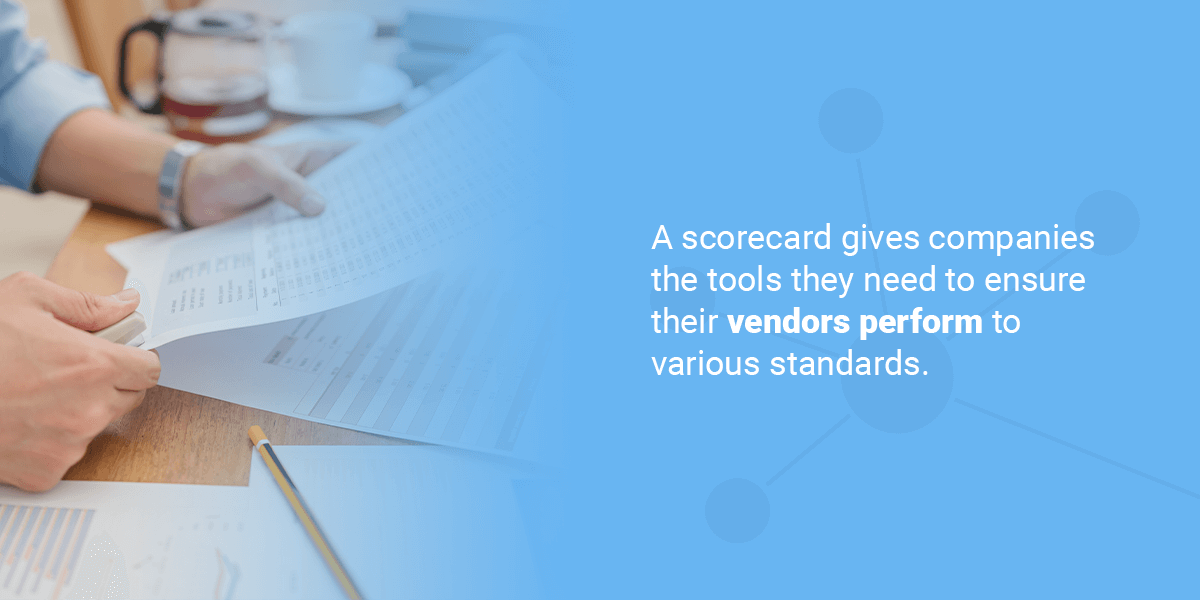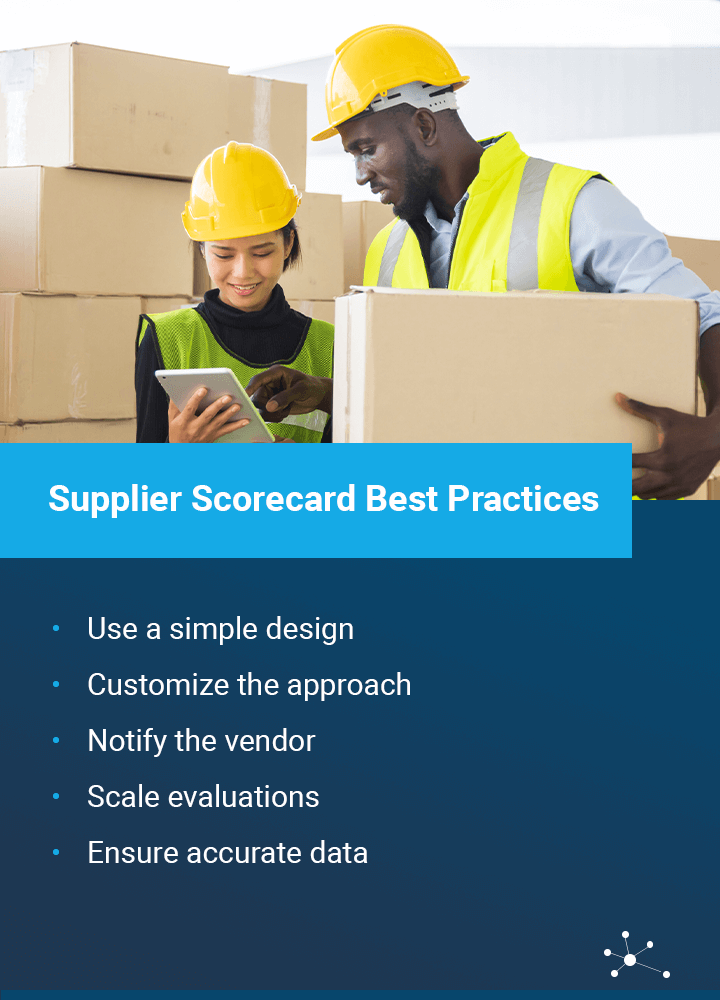
One of the best tools you can use to evaluate your vendors is a supplier scorecard. When a company wants better vendor and supplier management, a scorecard allows them to evaluate key metrics and determine how well its vendor is performing. Since vendors are crucial to an effective supply network, companies rely on supplier scorecards to determine if the vendor is providing them with high-quality service and efficiently moving products through the supply chain.
Review our guide to supplier scorecards to learn more about what these scorecards are and how you can successfully implement them at your company.
What Is a Supplier Scorecard?
Sometimes referred to as a vendor scorecard, a supplier scorecard is a document used by businesses to measure supplier performance and effectiveness. These measurements come from various systems and methods companies use to rank, rate and measure a supplier's performance. Supplier scorecards typically come with a few main categories and quantifiable factors. These factors may include metrics about vendor delivery time, customer service, costs and product quality.
Supplier scorecards are an essential part of vendor management, as they help companies monitor and better control their vendors' performance. When a company uses an effective vendor scorecard, it can improve its vendor assessments and increase its management ability. Essentially, a scorecard gives companies the tools they need to ensure their vendors perform to various standards.

By ensuring vendors stick to standards, a company can reduce risk and maximize its return on investment. Scorecards also help companies communicate their expectations to vendors and ensure the vendor is on the same page with their goals. Additionally, scorecards help companies calculate a service or product's total procurement cost and identify supply chain risks or gaps in service the company can take action on.
Who Uses Supplier Scorecards?
Procurement managers and strategic sourcing managers are generally the main users of supplier scorecards. While these managers tend to be the main administrators, other key company stakeholders may also play a role in supplier scorecarding. Supplier scorecard users will also report findings from the scorecard, such as supply chain health and vendor value, to their company's executives.
When to Use a Supplier Scorecard
Companies first use supplier scorecards when they hire a new a vendor. During onboarding, a company will go over the scorecard's criteria and their process for evaluating a vendor's performance with the vendor.
Many companies enjoy using their vendor performance scorecard early in their relationship with a vendor, as it allows both parties to go over the scorecard's criteria. Vendors can then agree to the evaluation metrics the company will be using to judge their performance, leading to greater understanding and satisfaction between both parties.
Once both parties have agreed to use a supplier scorecard, companies tend to use their scorecards quarterly or annually. Quarterly evaluations often involve a due diligence questionnaire and a basic supplier scorecard to ensure a vendor is performing duties effectively. Companies also typically conduct a more comprehensive annual review, where team members collect and review data about the vendor using the scorecard. Since the annual review will provide more insights, they can use it to improve their vendor relationship.
Companies also use scorecards when they want to increase transparency between themselves and their vendor. By having greater transparency, companies can better spot inefficiencies in their and their vendors' processes, helping them both achieve greater efficiency. Companies also use scorecards to encourage positive change. The evaluation from these scorecards gives companies a way to concretely list out issues in a vendor's service and provide constructive criticism for improvement.
How to Create and Execute a Supplier Scorecard
If you're hoping to implement a supplier scorecard, you'll likely want to know some ways you can best create and use one. This type of scorecard is usually based on the information listed in proposal documents and various criteria employed by other companies to evaluate supplier scorecards. As you create a supplier scorecard for your company, review the main steps for creating and implementing them:
1. Review Documents From Proposals
The first step to creating a supplier scorecard is to gather your vendor's original request for proposal (RFP) documents. You'll also want to review the contract you both agreed to and the vendor's RFP response. You'll likely have put a lot of research into selecting the vendor, so you can use the information you gained from this process to inform your vendor scorecard.
Many companies use weighted scoring in their RFPs, and they can use this scoring to determine what factors they need to give the most importance on the scorecard. You can also review the contract to find already established service level agreements (SLAs) that you can utilize on the scorecard as part of your metric. When you review the contract, list all these SLAs to use for the vendor scorecard.
2. Determine Key Supplier Scorecard Metrics

Once you've compiled and reviewed the initial guiding documents, you can move on to identifying the metrics you'll want to use on your scorecard. With clear vendor performance metrics, you can more easily evaluate a vendor's performance and communicate expectations to them. Some essential metrics associated with a successful supplier scorecarding program include lead and delivery times, quality of goods or services, responsiveness and capability.
- Lead and delivery times: When you rely on a vendor for your goods, you likely want lead and delivery times to be a short as possible. Therefore, it's important to track how long it takes for the vendor to receive and process an order. Alongside tracking lead times, this metric should include the time it takes for the vendor to deliver products to you. This metric can help you determine if the vendor is meeting your expectations and timeliness for receiving goods.
- Quality of goods or services: Another key metric is the quality of products, raw materials or services a vendor provides you. Quality standards for goods typically include their condition on delivery, criteria listed in the contract, meeting sales projections and the rate of return. For raw materials, such as those found in the construction industry, quality measurements will include whether the materials meet safety compliance standards.
- Responsiveness: Responsiveness metrics can assist companies in evaluating how fast and well a vendor responds to their concerns or requests. If a vendor consistently doesn't respond to emails, phone calls and other methods of communications, this can be a red flag indicating a larger issue with their overall reliability. Responsiveness measures can also help companies see how a vendor reacts when they make mistakes or have to adjust to any changes you make to your orders.
- Capability: A vendor must be able to meet the volume of product or material you need. As you evaluate a vendor's capability, you'll likely want to review the vendor's adaptability, production ability and financial stability. By reviewing the vendor's overall capability, you can better protect yourself from supply chain risks.
3. Start Vendor Evaluations
Once you've established your supplier scorecard metrics, you can use them to measure the vendor's performance. Companies generally apply a grading scale to certain metrics, with simple ones giving a simple yes or no answer to whether a vendor meets a particular standard. More advanced vendor assessments may grade different standards on a scale. You can also define what you consider a good or bad score on these evaluations to help guide your actions after grading the vendor.
While a vendor falling short in certain areas may mean you need to break ties with them, you can usually use your evaluation as a learning opportunity for the vendor. At times, you may even find that some of the reasons why a vendor isn't optimally performing are because of an issue on your end, such as poor communication.
You can go over your evaluation with the vendor and identify what issues might be causing poor grades in particular areas. Problems may come from accounting, merchandising or routing instructions, so it's important to narrow in on what's causing a vendor not to meet expectations. Once you've identified the underlying causes of poor grades, you can talk about them with the vendor, helping them take action to raise their performance before the next evaluation.
Supplier Scorecard Best Practices

As you create a supplier scorecard, there are a few scorecard best practices you can follow to ensure you get the most out of using one. Some best practices for getting the most out of your scorecard include using a simple design, customizing your approach, notifying your vendor of your evaluation, scaling evaluations and ensuring accurate data.
- Use a simple design: When you first design your supplier scorecard, it's a good idea to start simple. While you might be tempted to evaluate all the possible data, you'll likely get overwhelmed if you try to include all of it in your scorecard. You can often receive better results by starting simple and gradually adding more advanced metrics to the vendor scorecard after you get used to using the simpler version.
- Customize the approach: Since every company is unique, there's no one size fits all approach for creating a scorecarding program for your company. While you can use other companies' scorecards to get some ideas, you'll want to customize your metrics to your needs.
- Notify the vendor: Another best practice is to make sure your vendors know you'll be using a supplier scorecard. By notifying them, you make sure they don't feel blindsided when you start evaluating them, gaining their trust and building a better relationship as a result. Greater transparency with your vendor will also help them meet your expectations, as they'll be well aware of the criteria you'll be using to score them.
- Scale evaluations: You likely work with a few different vendors, and it's best practice to scale your evaluations based on the vendor's importance to your needs to avoid spending too much time on unnecessary evaluations. If a vendor is nonessential to your operations or plays a minor role, you can use a very simple supplier scorecard for your evaluations of them. However, a more important vendor will require you to scale up your evaluation to assess their performance properly and see if they need improvement.
- Ensure accurate data: You can only effectively use vendor scorecards if you have accurate data. As you create and implement your scorecard, you can use digital tools, such as RFT software, e-procurement programs and vendor management systems, to track and deliver precise data and insights about your vendors. Digital tools designed to automate data entry can also assist with providing you more accurate data, as these tools eliminate the need for manual entry and reduce the chance for user error.
Maximize Supply Chain Efficiency With ConnectPointz
At ConnectPointz, we know how important accurate data and transparent communication are to managing your supply chain and vendor relationships. Due to this need for accuracy and transparency, we offer several solutions designed to integrate communication connections between different areas of the supply chain, including better connecting a company with its vendors. With our solutions, you can increase accuracy, responsiveness and compliance in the supply chain process.
One popular option we offer to businesses and retailers is our integrated retail solutions. When you use this solution, our team can provide you with custom vendor integrations to make vendor onboarding easier. These custom integrations also help you automate the supply chain from your vendor to your business, potentially helping both of you achieve your goals. Our integrated retail solutions assist with data gathering and other essential processes, such as those related to order-to-cash automation, real-time compliance validation, fast implementation and critical time reports.
We also offer shipping and logistics integration solutions to help you get the most out of your vendor relationships. These solutions are designed to reduce costs and automate simple processes, assisting the various parties involved in your logistics network. Since our shipping and logistics integration solutions eliminate manual data entry and track data about the shipping process, you can better evaluate whether your vendor is properly delivering goods on your expected timeline.
Manage Vendor Relationships With the ConnectPointz Platform
With all of the solutions the ConnectPointz platform offers, we can help you simplify your vendor onboarding process and efficiently communicate with your existing vendors. Since we know every business is different, we're very flexible and regularly provide our clients with custom solutions to help them meet their goals. We also offer a fast and easy onboarding process to make integrating our solutions as convenient as possible. Alongside our excellent services, we pair them all with affordable and predictable pricing.
Register for a free demo today! If you have any questions, please feel free to contact us.










































